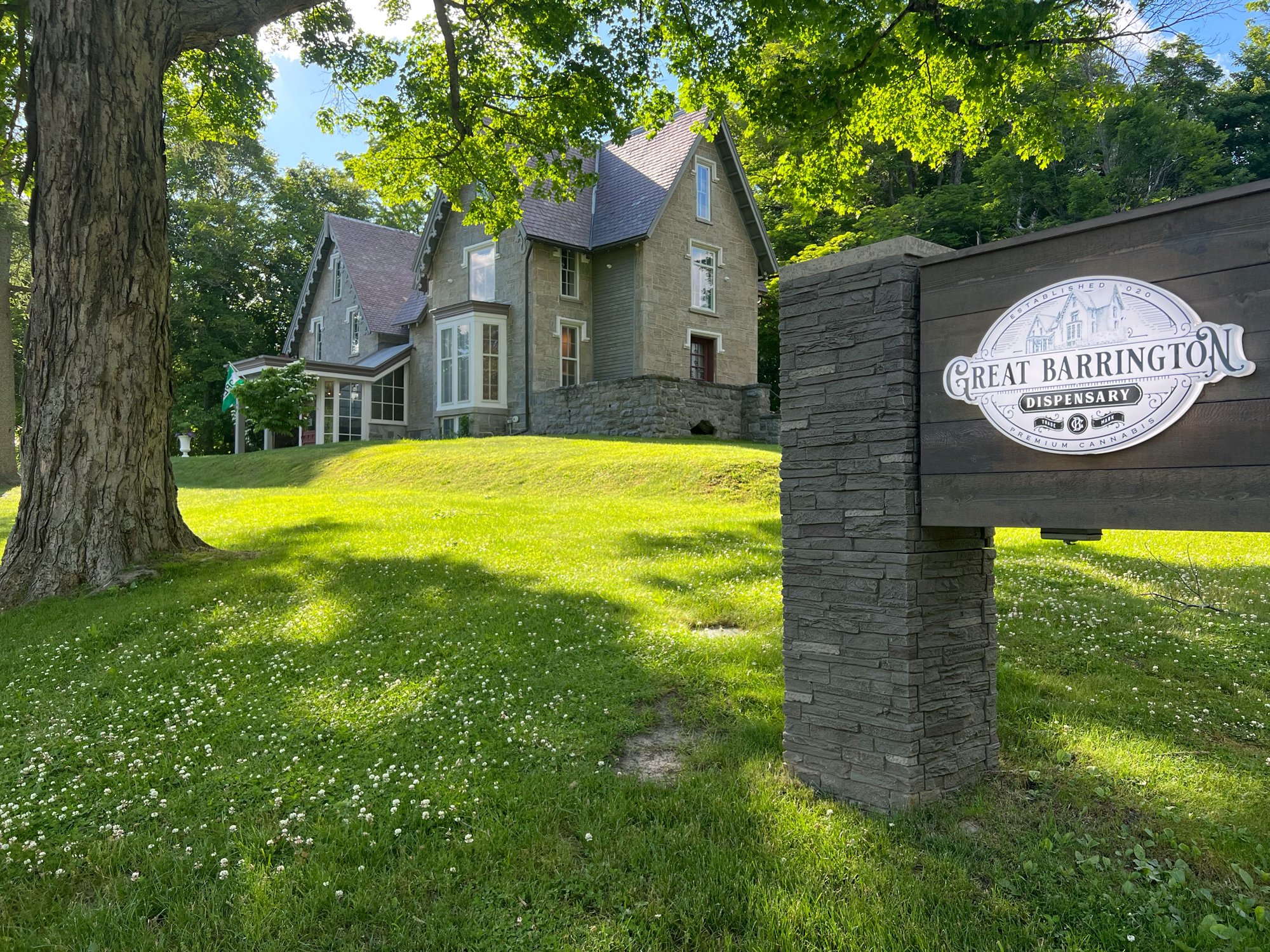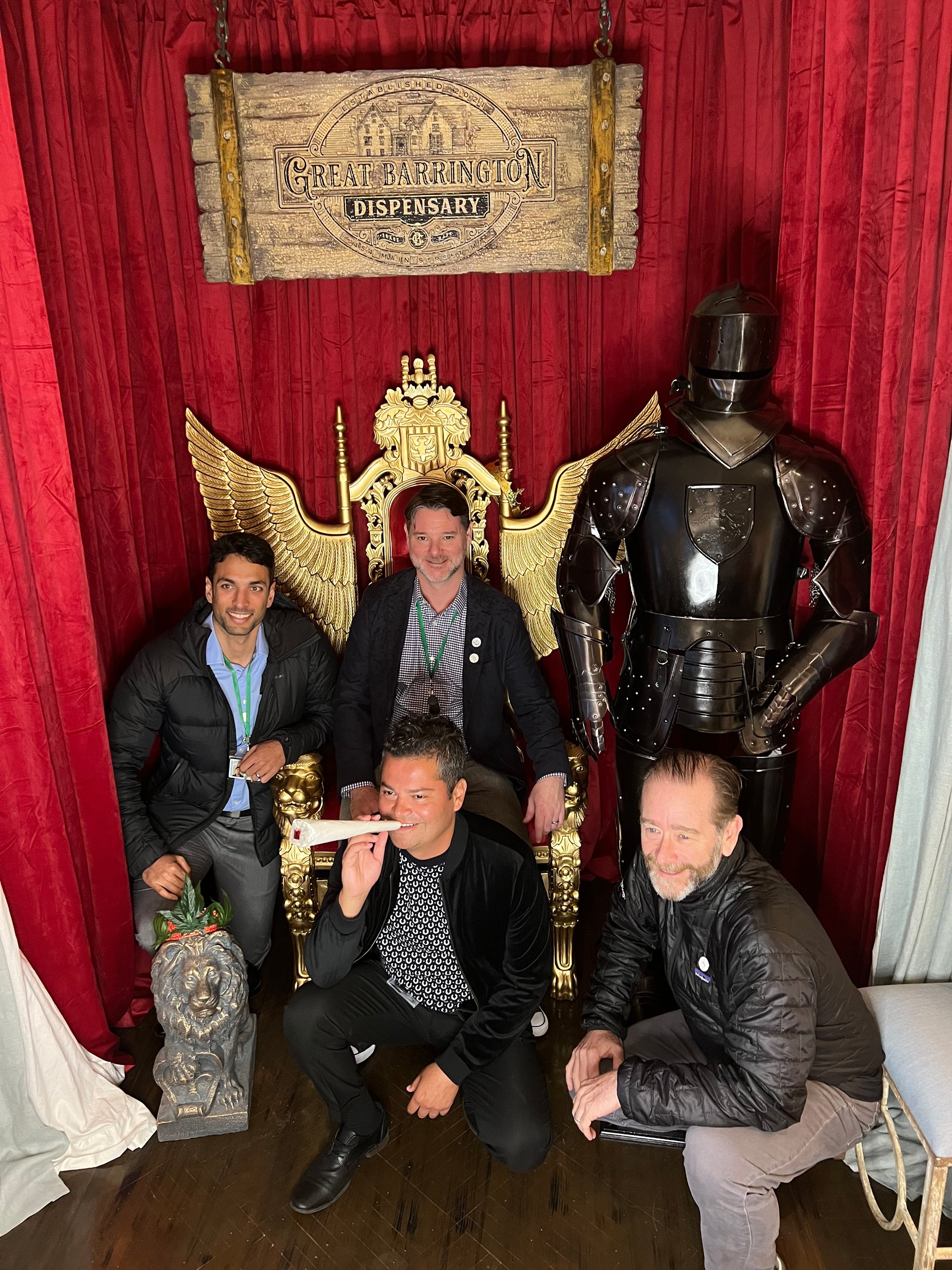The Cannabis Castle
A HOME WITH A LOT OF HISTORY IS NOW HOME TO CANNABIS
By Maisy Seckler // Photos Courtesy Great Barrington Dispensary
“People are surprised we are a dispensary,” says Krishna Gandhi, one of four owners of the Great Barrington Dispensary, located in an English Gothic revival mansion that sits atop a grassy knoll just outside the center of town. “They’re used to an over-the-top, modern and sleek retail store. We’re a unique, old-time charm, cannabis castle. It’s an amazing building.”
Gandhi’s favorite part of what was once known as “Indiola Place” is the grand entrance, where you can still see the original granite. Fake cannabis leaves blanket the entryway’s large wall, and their logo is front and center. He loves the mix of the original building with elements of new design and the cannabis. Guests—over 21, of course—are invited into the showroom, where display cases remain in place, a carry-over by McTeigue & McClelland Jewelers, handmade to match the build- ing’s original woodwork. They once dis- played heirloom jewelry and gemstones created by these well-known artisans. Now they display artisanal cannabis, some of which is the No. 9 brand—including the “Sunflower Collection,” pre-roll, pre-ground flower, a new vape collection, and buds that will be rolled out later this year.
That No. 9 brand is created by Coastal Cultivars, the company behind Great Barrington Dispensary that is renting the historic building from Walter McTeigue and Tim McClelland. They had been keeping an eye on different areas in the state to open a recreational cannabis dispensary, and a broker made the introduction to McTeigue and McClelland. “The timing was just right,” says Gandhi. “Our goals and values aligned. They wanted to preserve the building, and we love the build- ing. Not a lot of retail operations can work on that type of footprint, but cannabis is unique and a boutique experience. In many cannabis locations, people are handed a menu or look at a screen. Instead, they look at these beautiful display cases. We are trying to change the retail experience.”
It wasn’t only the building. They chose the Berkshires for their first retail operation in Massachusetts, because they love the area’s outdoor offerings—hiking, climbing, and skiing. Coastal Cultivars is one of Massachusetts largest outdoor cannabis farms, established in the spring of 2021 and boasting environmentally friendly growing practices. The licensed, four-acre cultivation field is located in the agriculture-rich community of Wareham, a half-mile from Buzzards Bay. The company’s four owners are Gandhi, Jarrad Glennon, Pepe Breton, and Benjamin Smith. Two are from the South Shore of Boston, and Breton has six Colorado cannabis dispensary locations, a greenhouse, and an indoor cultivation center. Gandhi was born and raised in Mansfield, Connecticut, and now lives in Golden, Colorado. He travels to the Berkshires often.
They opened the Great Barrington Dispensary on January 31 without a lot of fanfare, the fifth cannabis dispensary in Great Barrington. “There’s plenty of competition here,” says Gandhi. “With our partner’s retail experience in Colorado, we’re very familiar with running this business.”
They are ramping up their public exposure and sharing the spoils of their new location at 454 Main Street with a “Summer Lawn Series” every Saturday and Sunday from noon to 6 p.m., with free beer, games, and more. Supported by the Great Barrington Cannabis Dispensary and open to folks 21 and older, they will be collecting food and cash donations for the People’s Pantry of Great Barrington.
At the intersection of Main Street and Maple Avenue, this address has long had a spirited history, according to local historian Bernard A. Drew. Beginning in 1762, doctor Joseph Lee built a quaint, wooden-frame country home for himself on the 1.26-acre estate. Nearly 30 years later, Dr. William Whiting assumed the property from Lee. And again, in 1808, a physician purchased the land. This time, it was Dr. Samuel Barstow, who converted it to “Barstow Tavern,” a restaurant style that held a large influence on the seventeenth-century economy. Barstow Tavern didn’t just offer food and drink, but also unique entertainment for its customers. On September 30, 1812, the first elephant to ever visit Great Barrington bunked with Barstow and his wife, when they hosted a traveling road show. Intrigued locals could pay 50 cents to observe the animal. Barstow also operated a medical practice in this building until his death in 1813. The widowed Lavinia Wilcox Barstow remained in the home, and in 1822, William Cullen Bryant, his wife Frances Fairchild of Alford, and their two children—Fanny and Julia—became her roommates. Bryant was born to Peter Bryant and Sarah Snell, residents of Cummington, Massachusetts. He attended Williams College, and although he ended up withdrawing, Bryant was admitted to the bar in 1815. He practiced law for 10 years in Great Barrington, but his thirst for the arts needed to be quenched. Bryant then moved to New York City to pursue his poetry career, and he served as the editor of the New York Evening Post for 50 years. In 1849, the wooden structure was demolished. Two years later, doctor Clarkson T. Collins built a 5,719-square-foot English Gothic revival mansion, constructed of blue dolomite stone sourced from a nearby quarry, on its footprint. Collins was forced to migrate to southern Berkshire County from New York City due to his ill health.
Just like today’s residents of “The Hill” can walk right over to the Great Barrington Farmers Market, Indiola’s inhabitants had effortless access to the bazaar at the Fair Grounds. In fact, Collins’s houseguest and sister-in-law Rebecca Coffin loved the market. In a letter to a family member, she described the bountiful selection of local produce, “we ascended to the next floor and gazed at the choicest and largest variety of fruits I ever witnessed all of Berkshire raising… paintings and drawings were hung around beautifully executed by the Master and Misses of this county … elegant bouquets of many sizes shapes of choicest flowers, as we inhaled their delicious per- fumes and admired their radiant colors.” The serenity of farm-to-table living in the Berkshires is not a modern phenomenon.
In 1925, The Christian Science Society purchased Collins’s home and convert- ed it to a church. For the next 90 years, Indiola Place served God just like St. James Episcopal Church and St. Peter’s Church a few minutes down the road. In recent years, the building housed the Berkshire Waldorf High School, as well as McTeigue & McClelland Jewelers—and now the Great Barrington Dispensary.
The four owners of Great Barrington Dispensary include, from left on opposite page, Krishna Gandhi, Jarrad Glennon, in the chair, Pepe Breton, and Benjamin Smith. “It’s such a beautiful building,” says Gandhi. “I can’t imagine a better retail space.” Guests are invited into the showroom, where display cases remain in place, a carry-over from McTeigue & McClelland Jewelers, handmade to match the building’s original woodwork.
Rumor has it that during Collins’s owner- ship, the building also once served as a way station on the Underground Railroad that ferried slaves to freedom from the South during the Civil War. According to Gandhi, there are living spaces hidden in a corner in the basement, with a fireplace and what was once a kitchen. Budtenders claim they have seen shadows moving down there, says Gandhi, “but that sort of stuff goes unno- ticed by me.” What he has noticed, though, is that people are excited to walk into this majestic building that once seemed unap- proachable, and buy weed.
“It’s such a beautiful building,” says Gandhi. “I can’t imagine a better retail space. The fact it was built for a doctor, and people use cannabis for medicinal purposes—there’s a connection to its original intent.”



